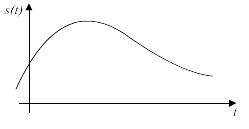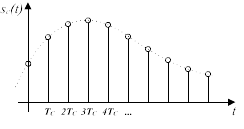Table of Contents
Analog Television
Dital Broadcasting -- IPTV and all others
reference. ETRI 보고서 PDF
Conversion of analogue television signals to digital signals → sampling
- sample rate: the quality of the representation of analog signals…
- benefits
- robust signals
- uses less bandwidth
그러나 영상 외에도 필요해지는 것
- sending (and receiving) information
- via one channel: one-way channel, broadcast channel, forward path, or in-band channel, etc.
- via two channel: two-way channel, interactional channel, return path, back channel or out-of-band channel, etc.
Oneway channel :: Near interactive way.
- Uses carousel to push the program content more likely to be requested
- e.g., 날씨정보, 교통정보 (특정시간대에), KOSDAC 정보
- 그림 참조
Two-way channel
- Each STB request content. This request goes to the application server, which will eventually send infomration (content) to the STB's ip address. It's more likely unicast.
- Problem? Server can be down if there are lots of requests.
- e.g., 월드컵 경기 중 베컴의 슈팅장면 모음집?
- 해결책으로는
- caching the information in advance.
- push the information to the multi-cast spot
- put the information to the broadband.
- 그러나, 이와 같은 사용자 요구는 수입원이 될 수 있음.
디지털 플랫폼: 물리적 경로
- 지상파
- 케이블
- 위성
- IP network
- 전화선
- 기타 등등.
위의 물리적 경로에 따라서, 디지털 방송 산업의 주체가 달라지는 경향이 있고, 이에 따라서, 디지털 방송의 표준이 달라짐.
아날로그에서 표준이 있었듯이 (NTSC, PAL, SECAM 등등), 디지털 방송에도 표준이 필요함. 이는 크게 유럽, 미국, 일본에서 개발, 제시되어 왔음 (참고, 최양수, 4장).
- DVB
- ATSC
세계의 표준
| Specification around the world | ||||
|---|---|---|---|---|
| US | Eroupe | Korea | ||
| 지상파 | 전송방식 | ATSC | DVB-T | ATSC |
| AV | MPEG-2 Dolby AC3 | MPEG-2 | MPEG-2 Dolby AC3 |
|
| 양방향TV표준 | ACAP | MHP | ACAP | |
| 위성 | 전송방식 | DSS, DVB-S | DVB-S | DVB-S |
| AV | MPEG-2 | MPEG-2 | MPEG-2 | |
| 양방향TV표준 | DirectTV | MHP | MHP | |
| 케이블 | 전송방식 | OpenCable | DVB-C | OpenCable |
| AV | MPEG-2 Dolby AC3 | MPEG-2 | MPEG-2 Dolby AC3 |
|
| 양방향TV표준 | OCAP | MHP | OCAP | |
크게 보면, 디지털 방송 표준이 있고 데이터 방송 표준이 있음. 디지털 방송 표준은 interactive 데이터 방송이 아닌 기존 아날로그 방송 표준처럼 디지털방송의 표준을 정한 것 (예, NTSC → ATSC; PAL → DVB2)
-
- 유럽 방송 기구 DVB에서 만들어진 양방향 TV 미들웨어 표준
- Java 기반의 규격이며, 이후 다른 양방향 TV 미들웨어 표준의 근간이 됨
- GEM (Globally Executable MHP)
- MHP에서 유럽 방송환경에만 쓰이는 요소를 제거하여 OCAP과 ACAP에 이용하기 용이하도록 한 표준임.
- OCAP (Open Cable Application Platform)
- 미국 케이블 방송 기구인 SCTE(Society of Cable Television Engineers) 에서 지원
- Cable Labs에서 제정한 양방향 TV 미들웨어 표준
- GEM에 Open Cable의 환경적인 요소를 추가하는 식으로 제정
- ACAP (Advanced Common Application Platform)
- 미국 방송 기구인 ATSC에서 제정한 양방향TV 미들웨어 표준
- GEM에 ATSC 지상파방송 환경요소 추가하는 식으로 제정
—-
- 한국은 매체 별로 MHP, OCAP, ACAP을 모두 사용하도록 표준이 되어있음.
- MHP, OCAP, ACAP은 GEM이라는 공통표준에 기반하고있어 Java API의 90% 이상을 공유하고 있음.
- 매체간 호환성 있는 양방향 TV 서비스 컨텐츠 제작시 기술적인 면보다 컨텐츠 제작환경과 사업적환경에 따른 호환성 문제가 있음.
- 한글 폰트, 한글 입력방식, 화면 해상도 문제
- 거래형 양방향 TV 서비스를 위해서 복잡한 매체별 사업 관계
—-
- DVB see http://dvb.org
- ATSC: Advanced Television Systems Committee
- DASE: Digital television Applicaiton Software Environment?
[http://www.opencable.com/ocap/ Open cable lab]]- [http://www.cablelabs.com/specs/| Open Cable Lab]] provides specifications and java stubs.
- Comparison between data broadcast specifications: Data broadcast server system 개요
2)
Analog TVs use a cathode-ray tube (CRT) to beam light against the backside of a screen. These tubes aren’t like projectors—they can’t fill up a screen in one go. Instead, they quickly beam light down from the top of a screen. As a result, though, the picture at the top of the screen starts to fade as the CRT beams light at the bottom of the screen. from https://www.howtogeek.com/428987/whats-the-difference-between-ntsc-and-pal/


